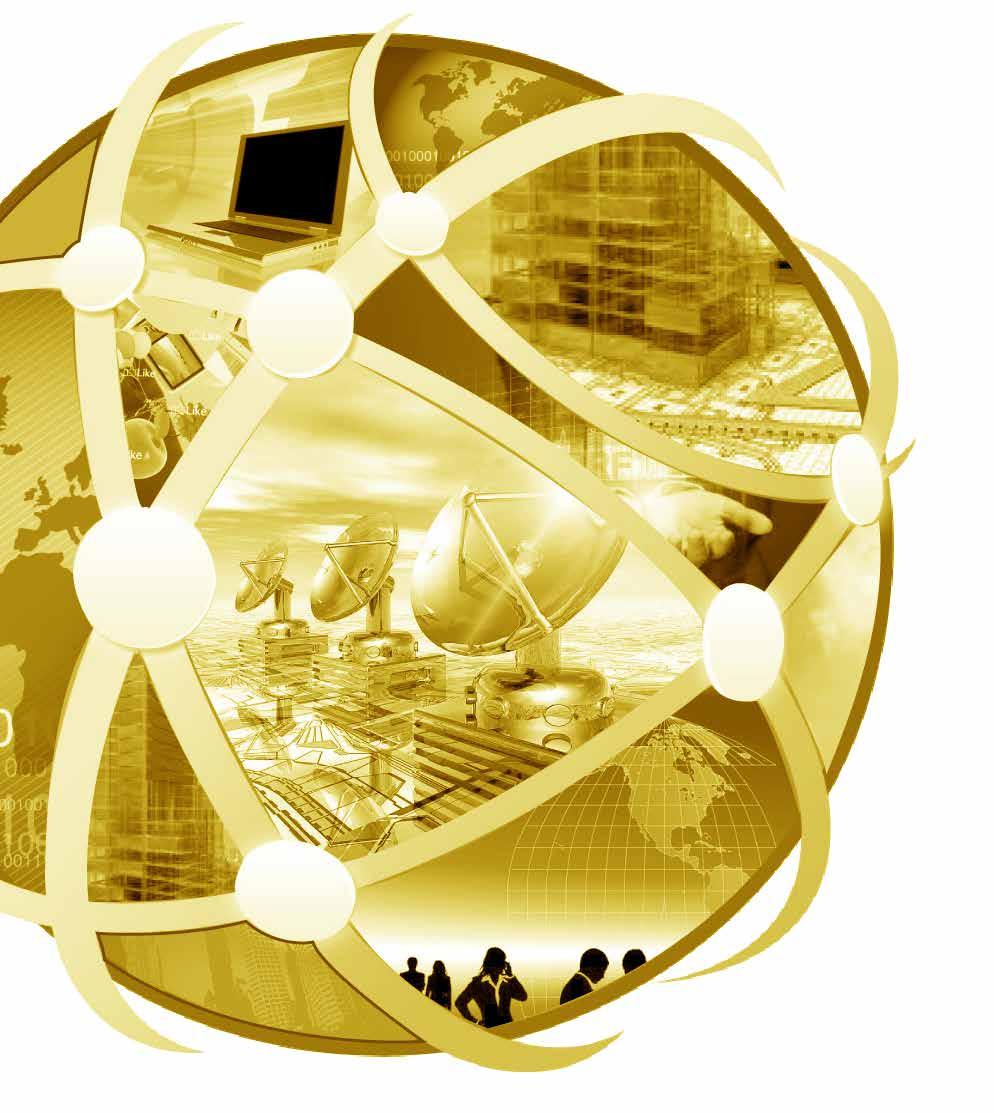
48 minute read
AIT Technology Event
from GREEN TECHNOLOGY
The AIT Technology Event

Advertisement

The AIT Technology Event explored the key benefits in adopting advanced technologies for the performance enhancement of organizations, businesses, and their specific projects. Over 200 delegates representing more than 130 organizations from more than 16 countries across Asia and the rest of the world attended the exclusive event.
The AIT Technology Event
The first AIT Technology Event was held at the InterContinental Hotel, Bangkok, Thailand from Wednesday, 10 July, to Thursday, 11 July. An Opening Ceremony Reception was held prior on 9 July, highlighted by the attendance of the Former Minister of Foreign Affairs of the Kingdom of Thailand and AIT alumnus, H.E. Dr. Subin Pinkayan.

The technology event explored the key benefits in adopting advanced technologies for the performance enhancement of organizations, businesses, and their specific projects. Over 200 delegates representing more than 130 organizations from more than 16 countries across Asia and the rest of the world attended the exclusive event. The primary focus of conversation was to convey how AIT can support research, development, and consulting services specific to real-estate and manufacturing industries. The event also drew on the Institute’s offerings from relevant and multi-disciplinary fields such as sustainability, information technology, and food security. Bringing together major stakeholders, including industry representatives, expert consultants, and policy makers, the AIT Technology Event facilitated a nexus for discussions characterized by multiple viewpoints and an exceptional quality of debate.
The format of the event involved a mixture of keynote speeches, presentations on topical issues, and extensive panel discussions, a full exhibition of AIT offerings, and plenty of scheduled time for formal and informal networking.
The two-day event addressed two themes.
Performance Enhancement of Tall Buildings, Real Estate, and Industrial Projects
Performance Enhancement of Manufacturing, Retail, and Distribution Enterprises
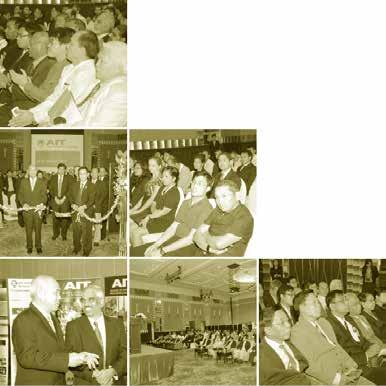
The following presents the main elements of discussions by the experts during the event.
On Public-Private Partnerships
H.E. Subin Pinkayan Stressing the importance of public-private partnerships (PPP), Chief Guest Speaker H.E. Dr. Subin Pinkayan (Water Resources Engineering ’61) said he was pleased that the event focused on how AIT’s technology could benefit the business sector.

The former Minister of Foreign Affairs, Thailand, Honorary Advisor of GMS Power Public Company Ltd., and AIT Hall of Fame inductee (2010) shared his successful experience of applying public-private partnerships (PPPs) to build a hydropower station in Lao PDR early is his career. He enjoined the engineers, academics, and senior business executives to select and implement projects that benefit the public.
Dawei Development: At the crossroads of Myanmar and Thailand
Somchet Thinaphong
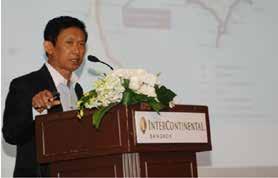
Prominent AIT graduate Dr. Somchet Thinaphong, Chairman, Geo-Informatics and Space Technology Development Agency, and President, Dawei Development Co., explained aspects of the large Dawei greenfield project in Myanmar. He emphasized the impact of AIT in the planned mega-project, saying it could fundamentally change Thailand’s neighbor. Many of the infrastructure elements of the project incorporate engineering expertise from AIT and are the result of 25 years of technology development, he said.
On the Fast Lane: Thailand’s Subway System
Chih Huang

Mr. Chih Huang, another successful alumnus, explained how Mass Rapid Authority of Thailand (MRT)’s mega-project to extend the Thai capital’s subway system also carries the imprint of AIT. According to Mr. Huang, the billion-Baht project expected to finish in March 2017 is providing many opportunities for AIT expertise to take the lead. “A large number of management consultants involved in project management are AIT alumni,” he said.

ASEAN is Rising: Trends and Innovations in Building and Chaovalit Ekabut Mr. Chaovalit Ekabut delivered the day’s Keynote Address titled ‘Trends and Innovations in Building Construction Industry in ASEAN.’ As the Vice President-Finance and Investment & CFO, SCG and President of SCG Investment, he spoke of his firm’s vision to be the region’s market leader by 2015. He noted the importance of research and development by citing how the company’s engagement with Ph.D. holders has grown over the years; from employing roughly six to seven employees with doctoral degrees ten years ago, to over 70 today. There are over 1,000 researchers and designers spread in all of SCG’s business units. The former AIT Alumni Association (AITAA) President illustrated how ASEAN is one of the world’s fastest growing regions based on the increase in cement consumption in the region, with Singapore leading. The majority of the ASEAN nations have a GDP of over 6% with the exception of Brunei and Singapore signaling the tremendous large-scale construction opportunities across the region. Construction Industry in the ASEAN
Mr. Ekabut poignantly mentioned how the Asian Financial Crisis has influenced Thai government spending - noting that government investment into infrastructure development, with the exception of the construction of the Suvarnabhumi Airport, has been minimal after 1997. Interestingly, the cases of Indonesia and the Philippines do not differ much. It is clear that at this time, the governments in this region realize that investment in key public infrastructure is a clear and present need.
He proceeded to provide an overview of Thailand’s mega projects which includes two mega projects on water management and flood prevention and the upgrade and expansion of the high speed train system. Other largescale projects include the construction of the third stage expressway, the second phase of the international airport, and expanding the trans-ASEAN road which will connect countries such as Myanmar, Thailand, Laos PDR, Cambodia, and Vietnam.
In closing, he reminded participants of the importance of environmental sustainability in any business plan, as today’s sophisticated investors look at both a firm’s profit and its attention to environmental concerns.
Designing and Constructing Buildings for Higher Performance, Cost Effectiveness and Sustainability:
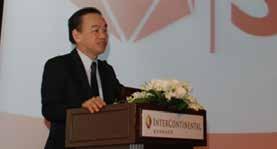
An Overview Naveed Anwar
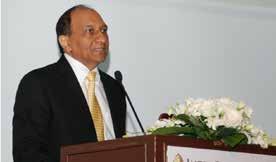
Dr. Naveed Anwar, Executive Director, AIT Consulting unveiled recent developments alongside an overview of issues in the development of tall buildings. He began by providing statistics on the rate of population growth and presented relevant opportunities that can be explored due to this gradual shift to accommodate increased urbanization as forecasted globally. He illustrated how an area being occupied by 10 families can be expanded to a 40-story building that could be divided into 200 residential units. One hot topic was on the fast-paced trends in Asia exemplified by the ongoing construction of 220-storey Sky City building in China set to be completed in 7 months juxtaposed with most of Europe’s resistance to the development of high-rises. For example, a tall building in the United Kingdom’s The Shard, which stands at 75-stories, took ten years to get approved and be built since first proposed, completing over 200 public hearings.
He then elaborated on AIT’s expertise in modeling, analysis, performance-based review and design of tall buildings, bridges, and other special structures and subsequent adaptations in different seismic zones. An example given was the opportunity to work on buckling restraint brace system (BRB) of a high-rise building in Manila, a first for the Philippines. The relationship between cost and performance was also discussed together with solutions and customizations for optimization.
How Safe are our Buildings for Earthquakes and Winds?
Pennung Warnitchai
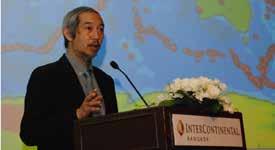
Dr. Pennung Watnitchai, leader of the Civil and Infrastructure Engineering Group of AIT’s School of Engineering and Technology (SET), elaborated on seismic hazard assessment, earthquake resistance of various structures, and other potential hazards.
He mentioned that the growth in height of tall buildings has been exponential rather than linear, and that diagrid system of buildings, which is popular in Western Europe may not be suitable for seismic zones in Asia. After providing visuals showing the devastating effects of differing ground motions and strong winds all over the world, he discussed the case of Bangkok where many tall buildings are located. A natural flood basin, the soil in Bangkok and peripheral provinces is characterized by very soft soil that can amplify the ground motion from areas as far as Sumatra and China, over 2,000 km away as in indication of seismic risks.
At AIT, Dr. Warnitchai and his team is trying to understand this issue more by measuring the dynamic characteristics of tall buildings, having completed over 100 buildings to date. Another team is working on understanding the soil basin further using the array microtremor measurement developed in Japan and is notably the best technology available today. This technology allows scientists to identify soil properties up to 1km deep.
Currently, the AIT team is measuring soil properties in 50 different locations in Bangkok.
Innovative Solutions for Foundations and Deep Basements
Dr. Noppadol Phien-wej of AIT’s Geotechnical and Earth Resources Engineering field stated that AIT performed pioneering work on land subsistence in Thailand. Noppadol Phien-wej
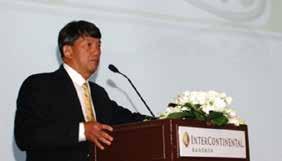
He noted that the construction particularly for urban areas including excavation requires emphasis on public safety while considering cost effectiveness as the duty of geotechnical engineers to society.
He provided an overview of the foundation and excavation work in soft soil citing experiences in Bangkok and Singapore as examples. Topics covered issues on ground water pumping, settlement and land subsidence, soil strength, deep excavation specifically in the context of urban development. He also mentioned the likely impacts of creating a channel and continuous digging in Bangkok, and highlighted the rising water table in the subsoil found in Chatuchak Park.
Dr. Phien-wej also gave specific techniques when performing deep excavation considering soil strength and water pressure by improving the soil on the base and applying a concrete crossbeam and dewatering to name a few.
What Makes Buildings Green and Sustainable?
Brahmanand Mohanty
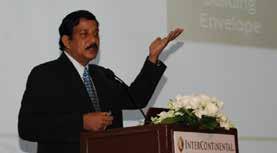
Dr. Brahmanand Mohanty, visiting faculty at Energy in AIT’s School of Environment, Resources and Development (SERD) revisited sustainable living approaches in the past and then showed how the human progresses since the advent of the industrial revolution have put humanity on an unsustainable path. He showed how homes built by ancestors ensured comfort of the occupants by exploiting locally available natural resources. It urged all to come full circle by blending the past wisdom with modern technology in achieving net-zero and energy-positive status for the buildings.
He noted that taller buildings are not only effective in fighting urban sprawl, but also required less materials per unit of useable floor space, and smaller surface area of envelope per floor area, thus minimizing the thermal exchanges with the surrounding. Taller buildings have the
potential to harvest solar and wind energy at height and they also provide opportunities to enjoy better air quality.
According to Dr. Mohanty, some disadvantages of high-rise residential buildings include less interaction with the occupants and the increased requirements of materials with high-embodied energy for the construction of safe and tall structures. The high-embodied energy can be justified if the buildings were designed to last longer, and consumed less energy by adopting passive design features, choosing energy efficient equipment and processes, and incorporating locally available renewable energies.
He recounted the three interesting human inventions over the past 100 to 150 years, notably elevators, electricity, and air conditioners, that were the key to the birth of high-rise buildings, symbolized by the famous Empire State Building in the United States.
He presented a sustainable energy strategy to achieve low-energy or net-zero energy buildings cost-effectively, especially in the context of developing Asia where the demand for increased floor space in residential, commercial and industrial buildings is huge. He then illustrated the virtue of retrofitting existing buildings by combining technology with building energy monitoring and control systems in order to keep both energy consumption and operating costs low. He finally concluded by emphasizing the role that national governments can play by creating public buildings that “lead by setting example”.
Managing Facilities and Properties through GIS-based Integrated Systems
Hamid Mehmood
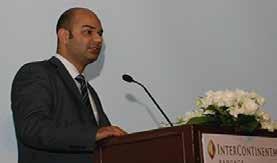
Dr. Hamid Mehmood, AIT alumnus and Assistant Professor at the Institute of Space Technology, Pakistan highlighted the importance of location data for evaluation systems for real-estate and properties applications.
Dr. Mehmood supplied information on the newly-developed FIMS – Facilities Integrated Management System, influenced by GIS-based monitoring and evaluation systems. Direct applications discussed were on site selection and strategic planning. For example, when markets change, FIMS can help determine existing locations and new markets to penetrate. egies to aide decision making for maintenance necessities in housing developments. The main advantage of utilizing FIMS is that it provides a visual output that can be manipulated to show data in a more useful manner.
Assessing and Managing Risk in Projects
Dr. Gregory L. F. Chiu of AIT’s Offshore Technology and Management field of study spoke about developing and implementing risk assessment.
Dr. Chiu directly addressed the ideas behind the profitable opportunities in risk management consultancy services.
He mentioned that nature of the consulting engineering is changing wherein experts are becoming technologists rather than professionals. He listed several new and improved engineering tools but was quick to remind the audience that the fundamentals in the disciplines have not changed. He puts forth the question on whether the educational process, apprenticeship process, and professional requirements as practicing engineers require better tools.
Additionally, he emphasized that having access to knowledge and tools is more lucrative in an environment where the clients demand lower cost for services.
Dr. Chiu then discussed the case of Yankee Stadium in New York City of how Building Information Modeling (BIM) aided timely completion and how a sophisticated database allows a superior system to manage the stadium particularly its maintenance.
He summarized risk management as the provision and quantification of a set of options based on probabilities as technical services. A complete statement of risk involves three components – dollars, probability, and time. Applications of risk management in the structural engineering practice equates to professional integrity assessments of structures that continually degrade such as those with high seismic risk, bridges, and waterfront structures. Arguably, he mentioned that structural engineers today define that the most difficult problem is converting engineering options into dollars.
Dr. Chiu believes that the ASEAN Economic Community (AEC) will not dramatically affect engineering practice but because of implementation, it will affect the industry somehow. It is increasingly important to have familiarity in risk management within the context of this region which requires consulting engineers to be aware of the various levels of hazards and vulnerabilities local to differing communities.
In closing, Dr. Chiu emphasized that AIT is distinctly international, relevant, and committed to developing solutions to problems using imaginative techniques and a strong vision. And that is the reason for holding a knowledge exchange of this kind - to convey the knowledge the Institute has harnessed over the years and build on the relevant to the engineering practice and technologies for the future. Gregory L. F. Chiu
Solutions and Systems for Social and Affordable Housing
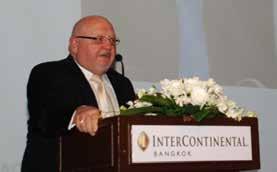
Naveed Anwar Gyanendra Sthapit
Following his presentation earlier, Dr. Naveed Anwar introduced this topic by addressing the gap between the average income of the major part of the population and cost to purchase residences. Three terms are being used interchangeably today: affordable housing, public housing, and social housing with the common denominator or requirements of affordability and the use of appropriate technology to achieve cost efficiency.
Mr. Gyanendra Sthapit of AIT’s Habitech Center then presented the innovative concept of interlocking bricks, micro concrete roofing which are all part of the Institute’s signature system for affordable housing. Known as Habitech Technology, this concept was developed at AIT and has been used in various places in Thailand and abroad. The materials are light, strong, and require relatively less time to produce. The technology has been applied in many circumstances as a solution for residential areas, educational and health facilities, renovation activities, self-help social housing projects, and to assist resettlement activities for disaster devastated communities. Managing the Extended Enterprise: An Enterprise Architecture Approach Prof. Thomas Gulledge, Professor Emeritus, George Mason University, United States and President, Enterprise Integration, Inc., United States presented on Managing the Extended Enterprise. The presentation focused on the design and implementation of solutions for supply chain integration & management. He discussed three main points: Enterprise Business Architecture, Extended Enterprise Integration, and Governance. He argued that a company needs all three of these topics to come together in the right kind of way in order to plan for extended enterprise or the Enterprise Planning and Management. Prof. Gulledge described Extended Enterprise Integration as inter-enterprise integration extended to incorporate other entities into the integration domain. These other entities include customers, suppliers, partners, and other organizational claimants. For Prof. Gulledge, the Thomas Gulledge
first stage of alignment is to try to understand how the plans inside of an organization relate to the processes. This has to do with the way managers organize their work to meet the requirements that are coming down from senior management. He elaborated on the importance of an organized database as it is an asset for an organization and a management responsibility to manage, own, and understand data. If the plans and the strategic directions of the organization align with the business processes, the data also align with the business processes only then can management control the organization and therefore align the systems as required.
Prof. Thomas emphasized that Enterprise Business Architecture is neither a compulsory nor a sufficient condition for success. Its success depends on how managers engage in and how they use it in order to solve particular problems. He further stressed that a plan does not guarantee success but a company is much more likely to succeed with a plan,
Practical Nanotechnology Today: Concepts to Applications
than without a plan. Joydeep Dutta
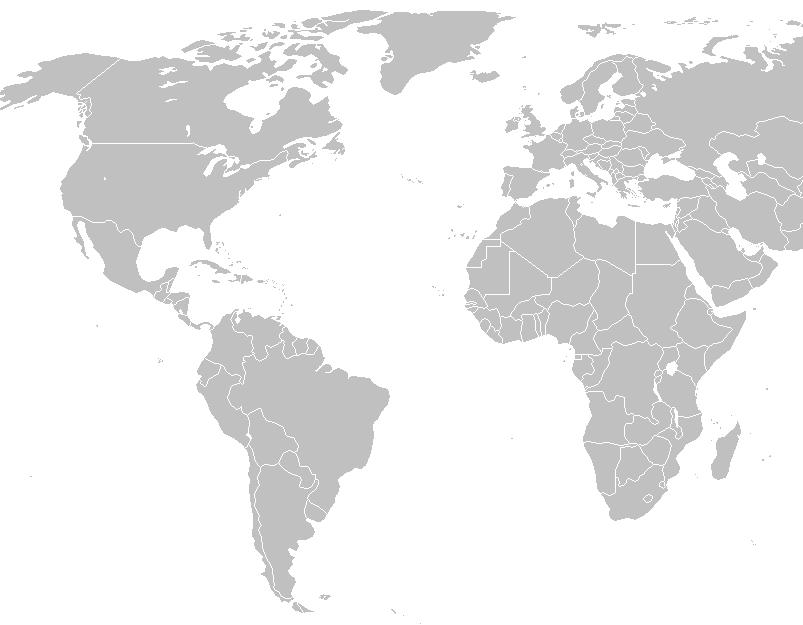
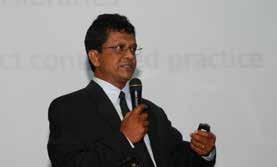
Prof. Joydeep Dutta centered his talk on why business entrepreneurs need nanotechnology to create new enterprises or improve their products that are in the market.
He started the session by sharing a brief background on how knowledge evolved throughout the years. He said that today knowledge levels double every 5 years, but tomorrow it is expected that knowledge will double within a few months. He talked about how in the past, businesses defined the products and presented them to the custom
ers but today customers decide what kind of products they want next. Prof. Dutta emphasized the importance of innovation, globalization, and the instant adaptation of new techniques. Prof. Dutta then unveiled developments in nanotechnology and how businesses can take advantage of this technology.
Prof. Dutta said, “Nanotechnology is the 21st century manufacturing technology irrespective of what business you are in and who you are. You will use nanotechnology in the future. And this is one of the reasons why the Asian Institute of Technology (AIT) started training master’s and doctoral students in nanotechnology since 2006. ” Prof. Dutta predicted that more and more academic institutions will have to integrate nanotechnology programs in the future.
He presented several nanotechnology applications that are already in the market from the information technology, energy, medicine, and consumer sectors. Some of the nanotechnology applications that are available today, and were also developed and refined in AIT, can be found in the current generation of solar cells, hydrogen production, water purification, LPG gas sensor, among others.
To end his presentation, he shared a quote from W. Edwards Deming, “It is not necessary to change. Survival is not mandatory.” He told the audience, “The choice is yours if you want to implement nanotechnology in your product or program because change is not mandatory if you don’t want to survive.”

Operation Model for Supply Chain Performance Transformation: What Does Good Look Like?
Phiraboon Phaiboontham
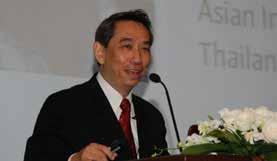
Mr. Phiraboon Phaiboontham explored the many facets of supply chain from a practitioner’s point of view.
Starting with a brief overview of the concepts of supply chain and performance transformation, he emphasized on three key implications of a supply chain: it is the core competency of modern enterprises, it covers the end-toend processes, and it implements strategies by making and turning them into process executions and routine works.
Delving on the characteristics of a good supply chain operation model and how it can help guide enterprises towards successful performance transformation, Mr. Phaiboontham introduced a world class supply chain reference model along with some selected samples on how to apply the operation model to improve supply chain performance. He highlighted that three key elements that a company needs to achieve performance transformation are: reorientation, revitalization, and recreation.
“Supply Chain Management is the core competency of modern enterprises,” he emphasized, “It is how value-added activities are driven and created, how competitiveness is defined and executed and how capabilities are built and sustained.”
He stressed that the supply chain performance transformation is a fundamental change to the way a business operates. It is an attempt to align organization activities with its business strategy and vision for a change aimed to meet long term objectives.
Process Driven Change: Supply and Demand Planning
Vatcharapol Sukhotu
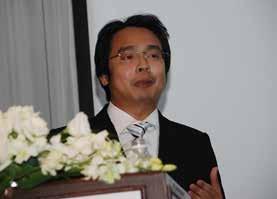
Dr. Vatcharapol Sukhotu began by stating the importance of having a solid single plan and looking at the big picture.
Dr. Sukhotu introduced the concept of supply chain, supply chain management, and the importance of forecasting or predicting something that may become a trend in the future. He mentioned that a company must try to minimize the cost of each part of the business and look at the end-to-end to see the bigger picture. He also added that supply chain planning is needed to increase competition, introduce new products more often, manage resources better, and minimize supply chain constraints. He emphasized that to optimize the whole process, companies must have an integrated plan characterized by demand, production, supply, inventory, storage, and transportation. He further elaborated that by creating an advanced planning system, companies will likely to achieve optimized end-toend supply chain process.
Dr. Sukhotu said that the keyword in the Supply Chain Management is coordination. The real challenge is how to properly coordinate people involved in the supply chain that will result in improved performance and increased revenue. He gave some guidelines on how a company can optimize the end-to-end supply chain process: collaboration must be built-in into the forecasting and demand planning process supported by the demand
planning system; data sources must interface through the demand planning system; planning of the demand, production, supply, inventory, storage, and transportation is integrated into a single plan; sales and operation planning (S&OP) process must be supported by scenario planning so changes made can be immediately simulated for better decision making and lead to a feasible plan; and replenishment decision from up-stream sources should be part of the supply chain planning with a level of automation.
Reducing the Carbon Footprint for Sustainable Production Practices Seeing the Big Picture: Sensing, Linking, Analyzing, and Visualizing Big Data
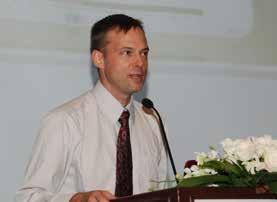
Brahmanand Mohanty
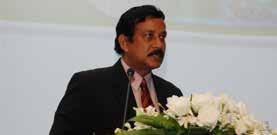
Dr. Brahmanand Mohanty introduced the concept of reducing the carbon footprint through sustainable production practices. He emphasized that by reducing the carbon footprint, we are also creating opportunities to innovate, reduce carbon emission, and generate financial returns.
Dr. Mohanty stated the need for an organization to analyze its carbon footprint in order to reap benefits that can then be translated into potential market advantages, better supply chain management, adherence to prevailing or future regulations, and GHG emissions reduction. He urged the audience to start taking the right steps in order to flourish in future by emphasizing that, “It’s not only about money but about sustainability in all senses.”
He recommended a three-step approach for an enterprise wishing to reduce its carbon footprint. He illustrated it by presenting case examples of the initiatives taken by two companies in this direction. Apple (manufacturer of IT products) and Mahindra Reva (manufacturer of electric cars) dramatically changed the configuration of their products and the whole supply chain in order to become energy-efficient while increasing their revenues at the same time.
Dr. Mohanty explained why it was important to evolve from traditional carbon management in which companies engage individually, to carbon management across the supply chain in which companies engage collaboratively up and down the supply chain and carbon savings come from both internal efficiencies and external process change and reorganization. He briefly presented the newly established ISO 14067 Standard aimed at supporting the assessment of life cycle GHG emissions of products, facilitating the reporting and communication with all stakeholders, and providing a common basis for the comparison of results arising from the use of this standard.
In summary, Dr. Mohanty advocated that carbon footprint reduction is a win-win solution wherein companies can reduce carbon emission and increase profits. Paul Janecek
Dr. Paul Janecek explained that Big Data refers to data that is too large, complex, and dynamic for any conventional data tools to capture, store, manage, and analyze.
He emphasized that the right use of Big Data allows analysts to spot trends and gives niche insights, creating value and innovation much faster than conventional methods. The challenge now lies in how to make data useable and actionable to make correct decisions.
Dr. Janecek presented an example of real-time monitoring conducted jointly by Think Blue Data and a U.S. company that focuses on detecting Hazardous Algal Blooms (HAB). The company uses Environmental Sample Processors (ESP), which are in-situ sensors that collect data in the open ocean, through underwater eco-genomic robots that detect DNA and toxins created by the algae. The ESP processes the data and continuously sends near real-time data back as images to the shore.
Dr. Janecek also mentioned that beyond sensing, there is also the linking, analyzing, and visualizing of the data before data can become actionable. Linking data refers to the process of taking one data point and assembling it with other relevant data points that are collected among many sensors. Analyzing data refers to the processing of data in the form of images into cell concentration. Visualizing data refers to the abstracting of the analyzed data in some kind of schematic form.
He explained how a data visualization portal works highlighting that this portal can detect any kind of immediate problem, for example the monitoring of Hazardous Algal Blooms is reduced from 3-5 days to 3.5 hours.
In conclusion, Dr. Janecek summarized the transformation of big data, from its collection from in-situ sensors to processing the data to make it actionable. He reiterated the current challenges faced by the 3Vs of Big Data: Variety, Volume, and Velocity; then highlighted some on research and technology wherein some applications such as data analysis, process analysis, business intelligence, decision support, and monitoring can be applied.
Cloud-enabled Collaboration for the Enterprise
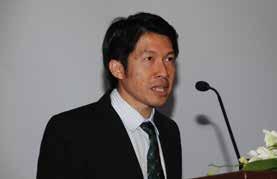
Matthew Dailey
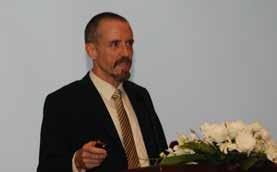
Dr. Matthew Dailey defined Enterprise Architecture (EA) as the systematic approach to transforming business strategies into a change management process. EA decomposes and optimizes the structure and purpose of an enterprise, beginning with a vision and strategy, identifying as-is architectures, analyzing gaps, and planning change. Some of the facets of an EA include business architecture, data architecture, application architecture, and technology architecture.
Dr. Dailey briefly discussed two complementary aspects of EA, business centric such as Business Process Management (BPM) and IT centric perspectives such as cloud computing and platform as a service. He highlighted that BPM uses technology to help humans focus on decision making by letting systems do the tedious work, achieve rapid change in the business process in response to customer needs, regulatory constraints, business opportunities, as well as to enable monitoring for bottlenecks and compliance.
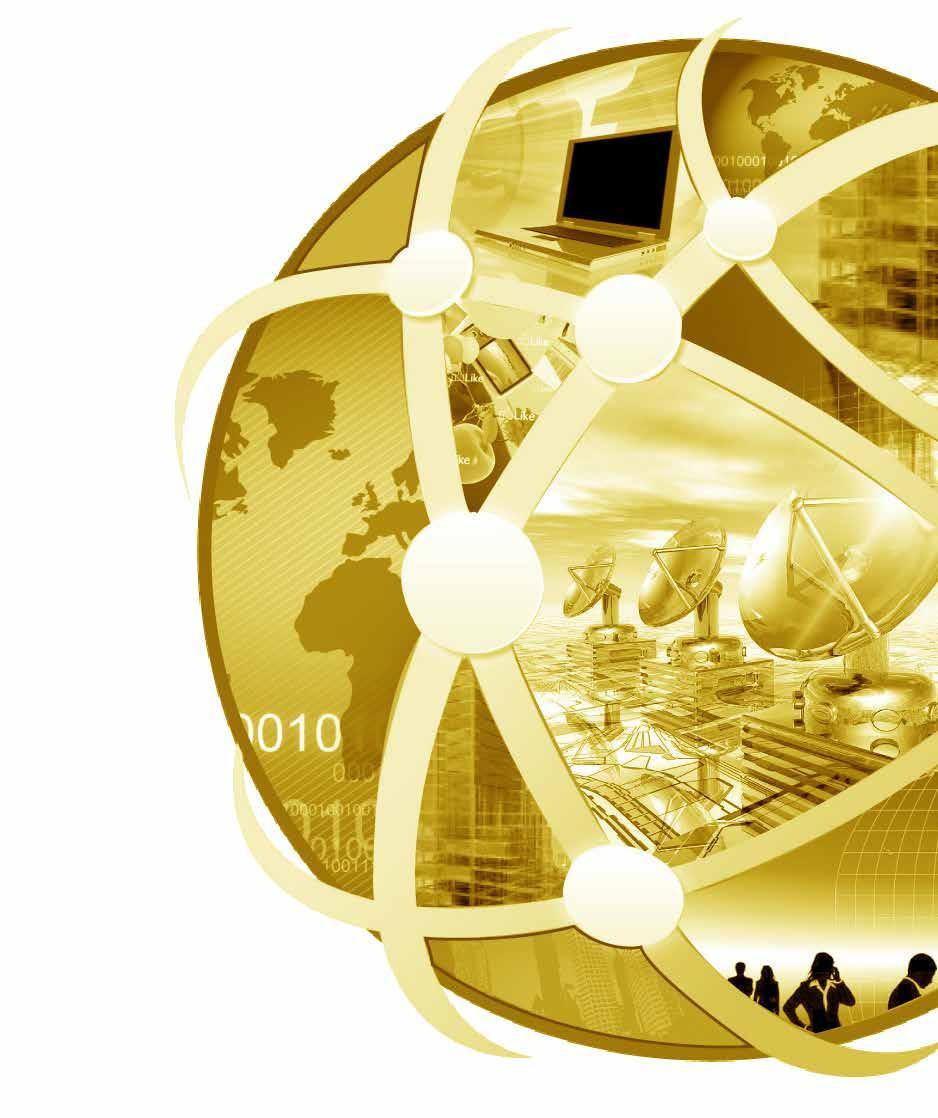
Dr. Dailey differentiated cloud computing the benefits of its adoption such as being able to “pay as you go” and access to high quality of IT services without the creation of a full IT department. He emphasized that this is a good way to try out solutions without committing to IT support resources that apply to all major cloud service models, including Infrastructure as a Service (IaaS), Platform as a Service (PaaS) and Software as a Service (SaaS).
Dr. Dailey concluded by highlighting the main prospects for cloud-enabled collaboration for the enterprise adding that very little may needed to get started and that the potential benefits are great.
Robots and Machines Development: from Imagination to Implementation
“AIT is the pioneering institution that launched a Mechatronics program in the region more than 10 years ago,” began Dr. Manukid Parnichkun.
He described the architecture of robots or machines in comparison to humans and/or living animals, as both consisting Manukid Parnichkun
of three main elements - sensors, processors, and actuators.
He explained that robots and machine study and development is known as Mechatronics Engineering, which is the synergic integration of 3 elements: mechanism, electronics, and computer engineering.
Dr. Parnichkun then highlighted seven Mechatronics projects at AIT, accompanied by short video clips. These seven projects include a flying robot that can be used for agricultural purposes such as pesticide or fertilization spraying, an underwater robot that can collect various types of information in deep waters, medical tele-analyzer that can diagnose abdominal mass remotely, and an intelligent vehicle project/smart car that can move autonomously from one place to another without a driver by using information from GPS, digital map, camera, and sonar. Another example of the work Dr. Parnichkun is the development of a gyroscopic unmanned bicycle that can balance itself automatically by using flywheel or centrifugal forces, and has the ability to balance people riding it, within a certain weight range. His team has also been working on exoskeletons that can be used to aid handicapped, paraplegic, or hemiplegic persons. The last research presented was the inverted pendulum which aims to evaluate the control performance of various control algorithms in balancing an inverted pendulum. An application is that the robot that can easily balance on a ball without falling over, and has the ability to send various types of useful information to the user.
Dr. Parnichkun projected that at least three robotics companies will be established in Thailand in the next three years to serve the needs of the country.
Prof. Chettiyappan Visvanathan’s topic on the innovations in waste management offered the participants valuable information about the current trends and technological advancements in solid waste management and wastewater.
According to Prof. Visvanathan, the difference between the 20th and 21st century in terms of waste management is the change in human perspective. Ten years ago, waste management was perceived as a problem worldwide because
Chettiyappan Visvanathan
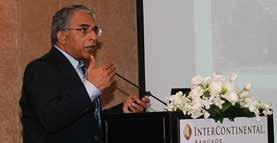
the methods of solid waste disposal had serious consequences for health and the environment.
With the advent of technological advancements, waste management is now being considered as a resource and an opportunity to earn revenue. The global trend is now moving towards Waste-to-Energy (WTE) for sustainable development.
In China, the government is taking major steps to increase its WTE capacity. In Singapore, the government has set up an integrated solid waste management system in the last three decades that incorporates recycling, collection, and disposal. In Thailand, technological research and development done at the Asian Institute of Technology (AIT) is currently being used and ventured into for industrial purposes.
Prof. Visvanathan emphasized AIT’s mission to work hand in hand with different industries to solve practical problems in solid waste and wastewater management for sustainable development.
Life Cycle Assessment of Products and Services to Assess Sustainability
Erik Bohez
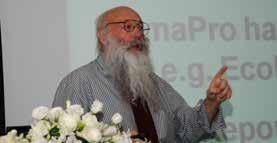
Ir. Erik Bohez’s presentation centered on answering three specific questions: What is Life Cycle Analysis (LCA)? What is Life Cycle of Product or Service? and What is Sustainability?
He defined LCA as the report on the total effect of emissions to the soil, water, and air during the life cycle of the product, including interpretation of data and subsequent recommendations. LCA requires data collection, surveys, defining scenarios or structuring data, defining the functional unit, and end reference flows.
By providing several examples on how LCA is conducted, Ir. Bohez then defined life cycle impact assessment by explaining its various methods based on classification, characterization, normalization, and weighting. of spoons made with aluminum, stainless steel, ceramic, wooden, and melamine materials. In this example, the functional unit and reference flows were based on using spoons of each type for a period of ten years, from the time the spoon was manufactured to the end of life of the spoon. The end of life scenario considered were land filling or recycling. The example was explained with screenshots from the Simapro software, several graphs, and process tree flowcharts for each spoon type as well as a comparative analysis of the spoons.
Sustainable and Safer Processing in Food Industries
Anil Kumar Anal
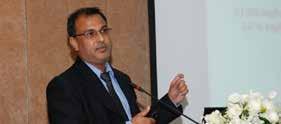
Dr. Anil Kumar Anal began his presentation by posing two main questions about food: Why do we eat when we eat? Why do we eat what we eat? He then talked about the changing trends in the food industry especially in terms of increasing obesity, increasing prevalence of diseases and the subsequent development of functional disabilities, increased health concerns of consumers, and the willingness to spend more for healthier foods.
He elaborated on how food can become functional by mentioning three factors including; changing food habits to natural types of food products, enriching formulated food with functional ingredients, and altering the composition of whole foods to enhance beneficial components such as breeding techniques, animal diet, and genetic engineering.
Dr. Anil presented several technologies used to enhance food processing as well as several future processing trends. He focused on the use of probiotics as a functional component in foods. Probiotics are live microbial feed supplements that have beneficial effects on the host by improving its intestinal microbial balance.
He provided several examples of the types of foods using probiotics such as certain yoghurts, cereals, and drink products.
He deliberated on the implications of research in food and pharmaceuticals, including industrial applications and health applications, and discussed other technologies such as microwave heating and pulsed electric field technology. He also offered varying opinions on antimicrobial use in livestock and poultry production, in particular on the co-relation, major issues, and concerns related to animals, individuals, and the general population.
Dr. Anil also discussed an approach that reduces the use of synthetic antibiotics by using Lactobacillus Plantarum and/ or other probiotics such as antibacterials. He also emphasized that nutrigenomics is an emerging tool in nutritional research as it increases growth, breeding, economic, food quality, and safety for livestock which in turn is converted to improvement in human health. Technology | April 2014
Water Treatment : The Clean Green Way
By Sunandan Baruah and Joydeep Dutta

Environmental pollution resulting from rapid industrialization has drawn attention to the pressing need for developing new environmentally friendly water purification techniques. Present water treatment techniques demand high capital investment; operation & maintenance costs together with large spaces for installation. Treatment of pollutants in a cost effective manner requires the transformation of toxic substances into benign forms supported by effective risk management strategies. Application of nanotechnology for water treatment can include options for removal of the smallest particulate contaminants (~100 nm) from water through the use of nano
Authors: Sunandan Baruah, Ph.D.
Associate Professor and Head, Department of Electronics & Communication Engineering, Don Bosco College of Engineering & Technology, Assam Don Bosco University, India
Water Scarcity In Orissa, India / Balaram Ranasingh porous membranes and “smart materials” that can specifically target pollutants and obliterate, transform, or immobilize them. Nanomaterials have been receiving a lot of interest of late for possible applications in the area of environmental remediation. Nanomaterials are attractive for properties like high surface area compared to volume and high surface reactivity. Heterogeneous photocatalytic systems via metal oxide semiconductors like TiO 2 and ZnO, are capable of operating effectively and efficiently for waste water treatment. Improved photo fenton techniques can also be a
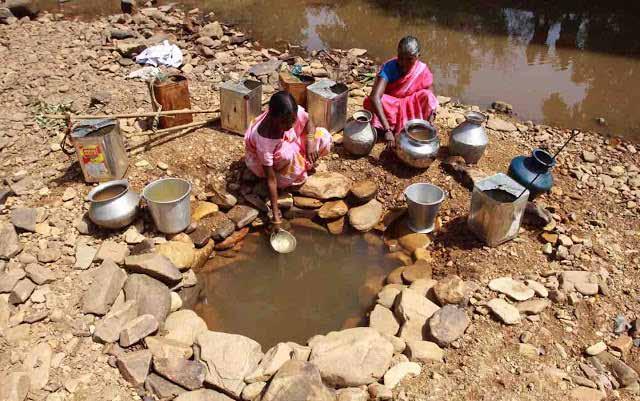
Joydeep Dutta, Ph.D.
Chair in Nanotechnology Sultan Qaboos University Muscat, Oman
green way of water purification.

Introduction
Most of the pollution problems faced by the world like high chemical contamination in air, water, and soil including compounds with high carbon content, are related to the rapid growth pace of global population. Current world population is about 6.5 billion and increasing at an alarming rate with a projected population of 9 billion by 2050. Extensive use of persistent chemical pesticides to boost agriculture production has contaminated ground water and also adversely affected our eco-system. Water pollution is probably the most challenging problem being faced by humanity in the twenty-first century. Fresh water is a necessity for life sustaining activities like drinking, cooking, cleaning, and agricultural activities. Human activities have disrupted the equilibrium between the consumption and natural purification processes leading to a shortage of fresh water. Out of 1,386 million cubic kilometers of water on Earth, only 3% is fresh water. Only about 0.1 million km 3 of water is above ground primarily in lakes, swamps, and rivers, while about 13,000 km 3 is in the atmosphere. Surface water has not increased for the past 2 decades, and groundwater
tables are also dropping. Seven hundred million people across the globe face water scarcity, and it is estimated that this problem will touch 1.8 billion people by 2025. Waterborne epidemics have almost been eradicated in the developed countries with the extensive use of chem- ical disinfection methods like chlorination and ozonation. However, water borne diseases are still alarmingly high in developing countries. Even in developed countries like USA, there were at least 1870 water borne epidemic out- breaks during the period from 1920 to 2002, an average of 22.5 per year. In the period from 1991–2002, 207 water borne disease outbreaks and 433947 illnesses were report- ed. According to the 2004 WHO report, at least one-sixth of the world population (1.1 billion peo- ple) lack access to safe water. Inferior quality drinking water continues to pose a major threat to human health. Diarrheal disease alone amounts to an estimated 4.1% of the total global bur- den of diseases and is responsible for the deaths of 1.8 million people every year. It was estimated that 88% of that fectively control microbial pathogens but results in the formation of harmful disinfection byproducts (DBPs). Chemical disinfectants commonly used for water purification like free chlorine, chloramines, and ozone can react with different chemical species present in natural water to form DBPs. Many of the reported DBPs (more than 600) are car- cinogenic in nature. The more resistant the microbes, the higher the dose of chemical disinfectants is required and the formation of DBPs is higher. It is therefore of utmost importance to develop innovative methods that improves the disinfection process without forming DBPs. Nanotech- nology is a disruptive technology that can possibly address these issues. Nanotechnology is an interdisciplinary science encompass- ing areas like physics, chemistry, biology, material science, and engineering. Nanotechnologists are capable of self-as- sembling atoms into structures with highly controlled properties. These nanostructures may be zero dimensional (nanoparticles), one dimensional (nanowires), two-dimen- sional (thin films) or three dimensional (arrays, hierarchical structures). Nanostructures can be obtained through two
different approaches that have been termed as top down process and bottom up process. The top down approach usually involves breaking down of big chunks of material (physically or chemically) into smaller objects of desired shapes and sizes using techniques like mechanical mill- ing and ion implantation. The bottom up approach uses self-assembly to build up the nanostructures by bringing in individual atoms and molecules together.
Nanomaterials offer large surface to volume ratios and
are exceptional adsorbents. Nanostructures of wide band gap semiconductors like zinc oxide (ZnO), titanium diox-
ide (TiO 2 ), and tungsten oxide (WO 3 ) are good photocatalysts and are capable of degrading harmful contaminants in water into benign forms in presence
of ultraviolet light. The advantage of
are that nothing should be added to the water and no
ZnO as a nanostructured photocatalyst material is that it can be engineered to absorb visible light thereby enhancing burden is attributed to unsafe water additional water to be strongly antibacterial on a variety supply, sanitation and hygiene and is of bacterial targets like Escherichia coli, mostly concentrated on children in de- should be used in the Staphyloccocus aureus, Bacillus subti- veloping countries. Water disinfection process. Further, the lis, to name a few. ZnO nanoparticles and microbial inactivation are there fore of prime importance. - treatment process showed maximum antibacterial activity on Staphyloccocus aureus compared itself should not to other semiconductor nanoparticles The criteria for a water treatment scheme to be considered green are add or generate any like MgO, TiO 2 , Al 2 O 3 , CuO, and CeO 2 . The antibacterial activity of ZnO can be that nothing should be added to the harmful chemicals. attributed to the binding of Zn 2+ ions, water and no additional water should released through dissolution, to the be used in the process. Further, the treatment process it- membranes of microorganisms thereby prolonging the self should not add or generate any harmful chemicals. The lag phase of the microbial growth cycle and photocatalytic currently employed chemical disinfection methods can efactivity upon light illumination. solar photocatalysis. ZnO is also reported Semiconductor nanostructures are being effectively uti-
lized in photocatalytic applications. The electron-hole pairs generated by solar radiation in semiconducting materials can catalyze oxidation-reduction reactions that destroy organic chemicals, a process with apparent environmental remediation potential. A significant amount of research on wide band semiconductor catalyzed photo-oxidation of organic chemicals has consequently been done during the past two decades. The ability to catalyze the obliteration of a wide variety of toxic long chained organic chemicals and their complete oxidation to CO 2 and dilute mineral acids,
lack of inherent toxicity, photo-stability and low costs ren- der this process attractive for environmental remediation. Two major disadvantages of TiO 2 -based photo-oxidation technology are the lack of adequate fixed bed reactor de- signs and the large band gap of TiO 2 (~3.2 eV). For bulk TiO 2 , this wavelength is in the near UV region, which means that only a small fraction (~3%) of the solar spectrum can be harvested.
Increased concern for environmental remediation has generated interest in the development of highly efficient photocatalysts that can participate in detoxification reactions. Removal of contaminants from water by photocatalysis has several advantages over conventional processes: direct conversion of pollutants to nontoxic byproducts without the necessity of any other associated disposal steps; use of oxygen as oxidant and elimination of expensive oxidizing chemicals; potential of using free and abundant solar energy; self-regeneration and recycling of the photocatalyst and so forth. It is, therefore, of no surprise that the research and development activities in this field have been very forceful in last decade.
Standard Green Water
Dissolved Oxygen Generators
Dissolved oxygen can effectively oxidize iron and manganese and allow their easy removal through filtration. Dissolved oxygen generators can create high levels of dissolved oxygen in water. Unpleasant iron, manganese, and hydrogen sulfide odors can also be removed using dissolved oxygen. An electrical current is allowed to pass through water, which splits water into hydrogen and oxygen. This process produces extremely small oxygen micro-bubbles, which are unable to break the surface tension of water. So the released oxygen remains dissolved in solution and is available for oxidizing chemical contaminants. Scientists are of the opinion that this process can also be Purification Techniques
used to remove Arsenic (III) from water.
Ultraviolet Treatment
pended solids or particulate matter, microbes may actually pass through the UV filter without being affected by the UV
Carbon Filters
The most efficient method of removing dissolved chlorine is by using carbon filters. Even though some carbon filters are primarily made from coal, the very best carbon filtration media is however granulated activated carbon, more popularly know as GAC. The best part of GAC is that it is made from coconut shells, which is a renewable resource. Activated carbon offers tremendous surface area (500 to 1,400 square meters per gram), which is a boon for surface reactions involved in water purification. Even though GAC is an effective material for removing chlorine, the disadvantage in its use is the growth of bacteria on it with time resulting in lower efficiency. Carbon filters therefore need to be replaced quite frequently.
Ozonation
Ozone becomes a powerful oxidizing agent after losing an atom of oxygen. This radical can adversely affect waterborne organisms. Ozone reduces by transferring the extra oxygen atom to any chemical that can be oxidized. The only by-product of ozonation is pure oxygen and the high oxygen content of ozonated water adds to the purification. Ozonation is capable of disinfecting water from viruses, algae, mold, fungus, and yeast spores. Ozone also oxidizes metal chemical contaminants like iron, sulfur and manganese, and the oxide precipitates can be filtered out. An ozone generating unit is normally installed in a water tank for Ultraviolet (UV) light, with wavelengths below 400nm purifies water by affecting the DNA of microbial contaminants like bacteria and viruses, severely damaging their reproductive system. The process is simple yet effective and eliminates more than 99 % of harmful microorganisms within a few tens of microseconds. UV treatment is an attractive purification technique, as no chemicals need to be added and the taste of the water is not affected. In certain cases, UV proved to be more effective in removing organic contaminants than chlorine. UV purification however is not used in centralized water treatment systems, as the effect is short lived. It can be considered an ideal disinfection process for residential applications. An UV water treatment system does have its own share of problems. In the presence of sus
the purpose of ozonation. light. Staining on the quartz sleeve resulting from untreated metals can adversely affect its disinfection capabilities.
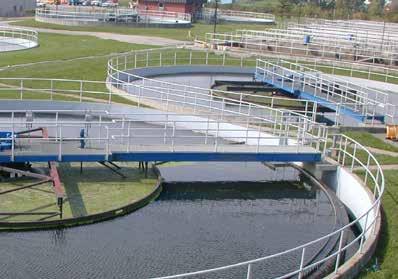
A typical wastewater treatment plant. The effects of nanoparticles on human health and the eco-system are not yet properly understood. This has necessitated the use of photocatalyst supports, which can be regenerated and can be conveniently removed.
Novel Green Water Purification Techniques
Photocatalysis
Photocatalysis is the acceleration of a chemical reaction in the presence of a light activated catalyst. The photocatalyst accelerates a reaction by interacting with the target either in its ground state or in its excited state and/or with the primary product, depending on the mechanism of the photoreaction. Heterogeneous photocatalytic systems based on solid metal oxide semiconductor photocatalysts has been an area of active research since the report of successful splitting of water into oxygen and hydrogen molecules through photo illumination of TiO 2 electrode. Photocatalysis is comparable to the natural photosynthesis process, as both require energy in the form of light radiation and a catalyst to accelerate the chemical reaction. Proper adsorption of the reactants to the photocatalyst surface is essential for efficient mineralization in both the cases. The illustration below shows a schematic comparison of photocatalysis and photosynthesis processes.
Electrons are exited from the valence band to the conduction band upon irradiation of a photocatalyst semiconductor surface with energy greater than its band gap. The electron hole pair (exciton) thus formed has a very short life span (typically a few picoseconds) and loses energy either through surface trapping, volume and surface recombination or reactions through interfacial charge transfer. Photo-exited electrons at the conduction band reduce adsorbed oxygen (O 2 ) or organic compound/dye, producing super oxide anion (O 2 -). The super oxide then reacts with hydrogen ion (H + ) producing hydroperoxyl radical (HO 2 - ) that later changes into water. Photo generated holes at the valence band can directly react with organic molecules and oxidize it to CO 2 , H 2 O and mineral salts. A free hole can oxidize hydroxyl ion to highly reactive hydroxyl radical.
A variety of photocatalyst nanomaterials have been reported in the literature. Oxides like titanium dioxide (TiO 2 ), zinc oxide (ZnO), iron oxide (Fe 2 O 3 ), tungsten oxide (WO 3 ), tin dioxide (SnO 2 ), silver oxide (Ag 2 O), vanadium oxide (V 2 O 5 ), strontium titanate (SrTiO 3 ) or sulphides like zinc sulphide (ZnS), cadmium sulphide (CdS), molybdenum disulphide (MoS 2 ), copper sulphide (Cu 2 S), silver sulphide (Ag 2 S), lead sulphide (PbS) or selenides like cadmium selenide (CdSe), lead selenide (PbSe), mercury selenide (HgSe) or iodides like silver iodide (AgI) and also modified systems such as coupled semiconductor systems (CdS/TiO 2 , CdSe/TiO 2 , SnO 2 / TiO 2 , ZnO/TiO 2 , ZnO/CdS), etc. Titanium dioxide (TiO 2 ), zinc oxide (ZnO), tungsten oxide (WO 3 ) and strontium titanate (SrTiO 3 ) are popular for the degradation of toxic contaminants from water mainly under ultraviolet (UV) light illumination. Of late, researchers are concentrating on visible light photocatalysis to exploit solar energy, as visible radiation
sunlight
CO 2 →
H2 O → Starch + O 2
Photosynthesis
harmless
CO 2 + H 2 O
toxic
Metal oxide hole
Organic polutant
OH
O2 + H 2 O → H 2 O 2
OH
electron e - + O 2
Photocatalysis
Figure 1: Comparison of photosynthesis process in leaves and photocatalysis using metal oxide nanoparticles. In the photocatalytic process, energy greater than the optical band gap of the semiconductors are generally required (compared to 2.5 eV for photosynthesis process).
constitutes a major portion (~ 46%) of the solar spectrum compared to UV light (~7 %). Photocatalysis using visible light has been reported to be possible through doping of semiconductors with transition metals to reduce the effective band gap and also through the incorporation of intentional defects into the semiconductor crystals during synthesis. The crystal defect initiated quasi-stable energy states within the band gap allow visible light absorption enhancing the generation of electron-hole pairs leading to higher photocatalytic activities. Part 2: Multiple Choices
Nanoparticles of metal oxides are efficient photocatalysts and can degrade both chemical and biological contaminants. The biggest limitation in the use of nanoparticles for practical applications is the difficulty of removing the particles after the treatment. The removal of these particles requires expensive post purification through nanofiltration usually together with flocculation and there is serious concern that these particles may ultimately affect the ecosystem. The effects of nanoparticles on human health and the eco-system is not yet been properly understood. This has necessitated the use of photocatalyst supports, which can be regenerated and can be conveniently removed.
An antibacterial water purifier was designed at the Center of Excellence in Nanotechnology, Asian Institute of technology using ZnO nanorods grown on polyethylene fibers. The water purifier was shown to successfully immobilize two model bacteria Escherichia coli and Staphylococcus aureus. The antibacterial activity of the ZnO nanorods was attributed to arise due to the combined effects of two mechanisms, release of zinc ions through slow dissolution of ZnO and the formation of reactive oxygen species through photocatalysis. Upto 99% (0.99x10 10 colony forming units per liter (CFU/L)) of the Escherichia coli and Staphylococcus aureus cells could be immobilized upon exposure to sunlight, while under room lighting conditions, 80% (0.8x10 10
CFU/L) of E. coli and 59% (0.59x1 10 CFU/L) of Staphylococcus aureus could be inactivated. Apart from fit to tap applications, the water purifier can be used in disaster areas to
Quiz : Bridges (Answers from page15)
Part 1: True/False 1. True 2. False 3. True 4. False 5. False
alleviate the scarcity of pure drinking water. A schematic 1. d 2. d 3. b 4.b 5.a
Quiz : Tall Buildings (Answers from page 40 )
Part 1: True/False 1. True 2. True 3. True 4. False 5. True
Part 2: Multiple Choices 1. a 2. b 3. b 4.d 5.c
Polluted water in Songhua River reaches Harbin, China / CDIC, REUTERS

figure explaining the concept of operation of the water purifier is shown in Figure 1. The inactivation efficiencies under illuminated conditions were observed to be almost double than those under dark conditions. Anomalies in supernatant Zn 2+ concentration were observed under both conditions as compared to control treatments, while cell membrane damage and DNA degradation were observed only under illumination. Inactivation in the dark was attributed to the bactericidal effect of Zn 2+ ions, while inactivation under illuminated conditions the inactivation is alleviated due to photocatalytic electron injection process. The Zn 2+ ions, released through dissolution, bind to the tip of pili of bacteria and prolong the lag phase of the bacterial growth cycle thereby checking reproduction. Strong radicals generated through photocatalysis can disrupt bacterial cell walls creating permanent damage. The inactivation of pathogenic bacterial densities by the ZnO nanorods in the presence of visible light implies potential ex situ application under sunlight for water decontamination at ambient conditions. The levels of dissolved ZnO post-catalysis were determined to be non-lethal. The degree of cell membrane damage among the test organisms was measured using a novel technique based on endonuclease pre-treatment, where evidence of possible DNA damage was also found 18 .
Conclusion
Environmental protection and pollution issues are frequently debated as topics that need to be addressed with urgency. Nanotechnology can endeavour to provide and fundamentally streamline the technologies currently used in environmental detection, sensing and remediation. Some nanotechnology applications are near commercialization: nanosensors and nanoscale coatings to replace thicker, more wasteful polymer coatings that prevent corrosion, nanosensors for detection of aquatic toxins, nanoscale biopolymers for improved decontamination and recycling of heavy metals, nanostructured metals that break down hazardous organics at room temperature, smart particles for environmental monitoring and purification, nanoparticles as a novel photocatalyst for environmental catalysis and so forth.
Richard Feynman, an eminent physicist and a Nobel Laureate said in his famous lecture in 1959 :
“ The biological example of writing information on a small scale has inspired me to think of something that should be possible. Biology is not simply writing information; it is doing something about it. A biological system can be exceedingly small. Many of the cells are very tiny, but they are very active; they manufacture various substances; they walk around; they wiggle; and they do all kinds of marvelous things – all on a very small scale. Also, they store information. Consider the possibility that we too can make a thing very small which does what we want – that we can manufacture an object that maneuvers at that level!”
And that was more than five decades back! Of course, it has not been possible till date to realize all that Feynman predicted, but the future will definitely show new applications of nanotechnology in the field of water purification and environmental remediation.
References
J. Sawai (2003) Journal of Microbiological Methods, 54, 177-182. M. F. Craun, G. F. Craun, R. L. Calderon and M. J. Beach (2006) Journal of Water and Health 4, 19-30. M. Marcucci, I. Ciabatti, A. Matteucci and G. Vernaglione (2003) Annals of the New York Academy of Sciences, Editon edn., vol. 984, pp. 53-64. M. R. Wiesner, G. V. Lowry, P. Alvarez, D. Dionysiou and P. Biswas (2006) Environmental Science and Technology, 40, 4336-4345. N. Jones, B. Ray, K. T. Ranjit and A. C. Manna (2008) FEMS Microbiology Letters, 279, 71-76. Q. Li, S. Mahendra, D. Y. Lyon, L. Brunet, M. V. Liga, D. Li and P. J. J. Alvarez (2008) Water Research, 42, 4591-4602. S. Atmaca, K. Gul and R. Clcek (1998) Turkish Journal of Medical Sciences, 28, 595-597. S. Baruah and J. Dutta (2009) Environmental Chemistry Letters 1-14. S. Baruah, C. Thanachayanont and J. Dutta, Science and Technology of Advanced Materials, 2008, 9. S. Baruah, R. F. Rafique and J. Dutta (2008) Nano, 3, 399-407. S. Baruah, S. S. Sinha, B. Ghosh, S. K. Pal, A. K. Raychaudhuri and J. Dutta (2009) Journal of Applied Physics, 105, 074308. S. Hirano (2009) Environmental Health and Preventive Medicine, 14, 223-225. S. R. Lewis, S. Datta, M. Guia, E. L. Cokera, F. E. Huggins, S. Daunert, L. Bachas and D. Bhattacharyya (2011) PNAS, 108, 8577-8582. S. W. Krasner, H. S. Weinberg, S. D. Richardson, S. J. Pastor, R. Chinn, M. J. Sclimenti, G. D. Onstad and A. D. Thruston Jr (2006) Environmental Science and Technology, 40, 7175-7185. World Health Organization http://www. who.int/water_sanitation_health/en/ factsfigures04.pdf World Health Organization Burden of disease and cost-effectiveness estimates, http://www.who.int/water_sanitation_ health/diseases/burden/en/index.html Z. Huang, X. Zheng, D. Yan, G. Yin, X. Liao, Y. Kang, Y. Yao, D. Huang and B. Hao (2008) Langmuir, 24, 4140-4144.







